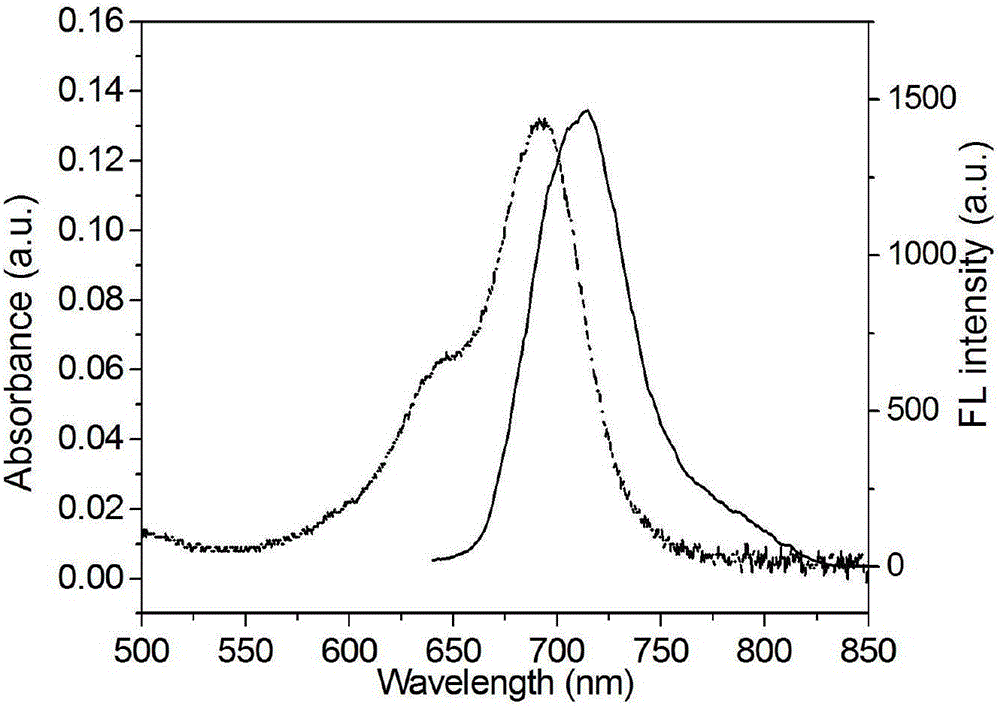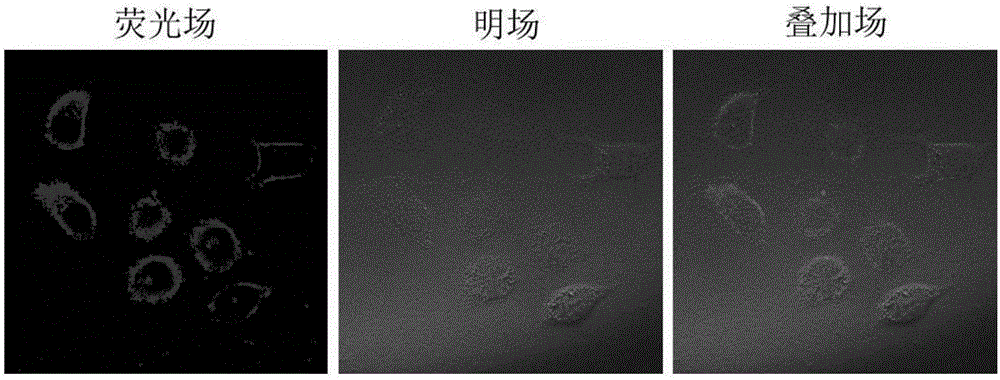Near-infrared fluorescent dye and synthesis method thereof, and application of near-infrared fluorescent dye in parasite fluorescence labeling
A technology of fluorescent dyes and synthesis methods, applied in the field of biological optical labeling, can solve the problems of inability to observe fluorescence for a long time, poor stability, and interference of biological spontaneous background fluorescence.
- Summary
- Abstract
- Description
- Claims
- Application Information
AI Technical Summary
Problems solved by technology
Method used
Image
Examples
Embodiment 1
[0028] Fluorescent dye NIR-COOH-SO 3 Synthesis of H:
[0029]
[0030] (1) Synthesis of M-1: Add 1mmol of 1,1,2-trimethyl-1H-benzindole and 1.2mmol of 3-bromopropionic acid into a three-necked flask, then add 30mL of toluene as solvent. Under the protection of nitrogen, the reaction system was reacted at 110° C. for 24 hours. After cooling to room temperature, the reaction solution was extracted with dichloromethane (10 mL×3), the organic layers were combined, dried over anhydrous sodium sulfate, and separated by column chromatography to obtain M-1. NMR characterization data: 1 H NMR (400MHz, CDCl 3 )δ8.07(dd, J=13.6,8.3Hz,5H),7.80–7.54(m,2H),4.05(d,J=7.0Hz,2H),3.26(s,5H),1.87(s,6H ), 1.19 (t, J=6.9Hz, 3H).
[0031](2) Synthesis of M-2: 1 mmol of M-1 and 1 mmol of N,N'-diphenylformamidine were dissolved in 25 mL of acetic anhydride, and reacted at 110°C for 2 hours. Cool to room temperature, neutralize by adding aqueous sodium bicarbonate solution, extract the reacti...
Embodiment 2
[0034] Fluorescent dye NIR-COOH-SO 3 Absorption spectrum and fluorescence spectrum test of H:
[0035] Fluorescent dye NIR-COOH-SO 3 H made into 1mmol·L -1 The ethanol stock solution was then diluted for testing. Ultraviolet Spectrum Measurement: The scanning range is 500nm-850nm, and the ultraviolet absorption spectrum characteristics are recorded. The solution determined above was then used to measure the fluorescence spectrum. Fluorescence spectrum measurement: the excitation wavelength is 620nm, and the emission spectrum range is 640nm-850nm. Absorption and fluorescence spectra such as figure 1 As shown, the test results show that the emission peak of the fluorescent dye is located in the near-infrared region of 650-850nm.
Embodiment 3
[0037] Fluorescent dye NIR-COOH-SO 3 Cell fluorescence imaging of H:
[0038] (1) Reagents and materials
[0039] Dimethyl sulfoxide (AR) was purchased from Aladdin Chemical Reagent Co., Ltd., RPMI 1640 culture medium was purchased from Thermo Fisher Scientific, and human cervical cancer cell HeLa was purchased from Shanghai Institute of Biochemistry and Cell Biology, Chinese Academy of Sciences.
[0040] (2) Cell fluorescence imaging
[0041] Human cervical cancer cells HeLa were cultured in RPMI 1640 medium containing 10% fetal bovine serum at 37°C, 5% CO 2 And 95% air atmosphere adherent growth. Fluorescent dye NIR-COOH-SO 3 The cell fluorescence imaging of H was tested on OLYMPUSFV1000 laser confocal fluorescence microscope, the excitation wavelength was 635nm, and the fluorescence signal of 650-750nm was received. Cell fluorescence imaging results such as figure 2 As shown, the experimental results show that the dye NIR-COOH-SO 3 H is good for fluorescently labeli...
PUM
 Login to View More
Login to View More Abstract
Description
Claims
Application Information
 Login to View More
Login to View More - R&D
- Intellectual Property
- Life Sciences
- Materials
- Tech Scout
- Unparalleled Data Quality
- Higher Quality Content
- 60% Fewer Hallucinations
Browse by: Latest US Patents, China's latest patents, Technical Efficacy Thesaurus, Application Domain, Technology Topic, Popular Technical Reports.
© 2025 PatSnap. All rights reserved.Legal|Privacy policy|Modern Slavery Act Transparency Statement|Sitemap|About US| Contact US: help@patsnap.com



